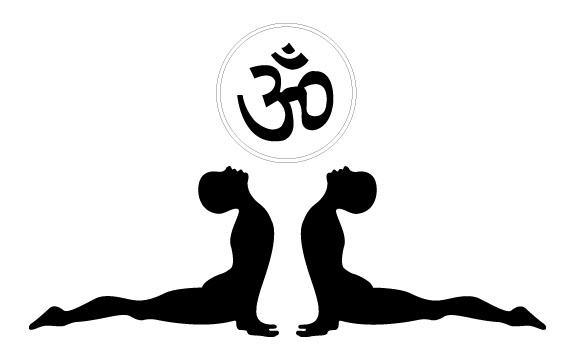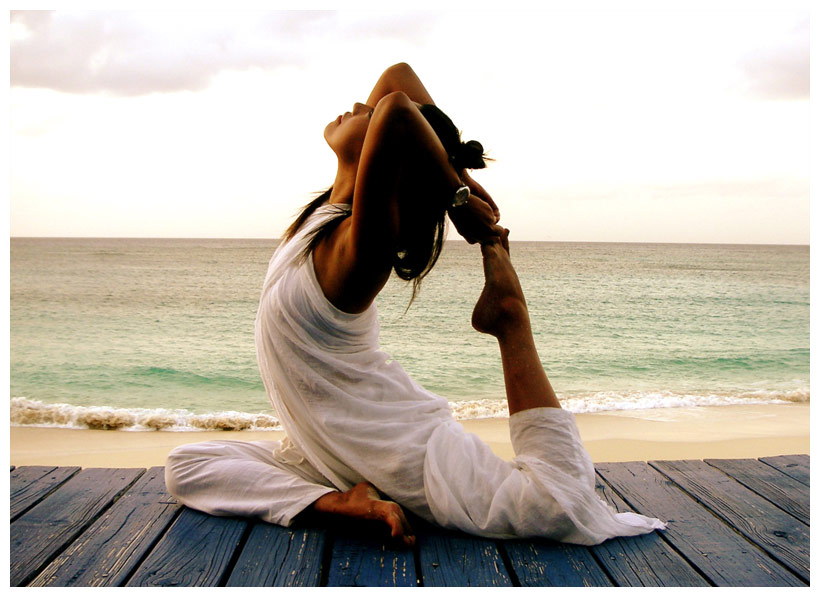
Are you looking for a workout program that's easy to learn, requires little or no equipment, and soothes your soul while toning your body? If strengthening your cardiovascular system, toning and stretching your muscles, and improving your mental fitness are on your to-do list, keep reading to learn more about the basics of yoga.
What Is Yoga?
It seems like a hot new trend, but yoga actually began more than 3,000 years ago in India. The word yoga is Sanskrit (one of the ancient languages of the East). It means to "yoke," or unite, the mind, body, and spirit.
Although yoga includes physical exercise, it is also a lifestyle practice for which exercise is just one component. Training your mind, body, and breath, as well as connecting with your spirituality, are the main goals of the yoga lifestyle.
The physical part of the yoga lifestyle is called hatha yoga. Hatha yoga focuses on asanas, or poses. A person who practices yoga goes through a series of specific poses while controlling his or her breathing. Some types of yoga also involve meditation and chanting.

There are many different types of hatha yoga, including:
- Ashtanga yoga: Ashtanga yoga is a vigorous, fast-paced form of yoga that helps to build flexibility, strength, concentration, and stamina. When doing Ashtanga yoga, a person moves quickly through a set of predetermined poses while remaining focused on deep breathing.
- Bikram yoga: Bikram yoga is also known as "hot yoga." It is practiced in rooms that may be heated to more than 100° Fahrenheit (37.8° Celsius) and focuses on stamina and purification.
- Gentle yoga: Gentle yoga focuses on slow stretches, flexibility, and deep breathing.
- Kundalini yoga: Kundalini yoga uses different poses, breathing techniques, chanting, and meditation to awaken life energy.
- Iyengar yoga: This type of yoga focuses on precise alignment of the poses. Participants use "props" like blankets, straps, mats, blocks, and chairs.
- Restorative yoga: This practice allows the body to fully relax by holding simple postures passively for extended periods of time.
- Vinyasa/power yoga: Similar to Ashtanga yoga, these are also very active forms of yoga that improve strength, flexibility, and stamina. This type of yoga is popular in the United States.
Yoga has tons of benefits. It can improve flexibility, strength, balance, and stamina. In addition, many people who practice yoga say that it reduces anxiety and stress, improves mental clarity, and even helps them sleep better.


Getting Started
Many gyms, community centers, and YMCAs offer yoga classes. Your neighborhood may also have a specialized yoga studio. Some yoga instructors offer private or semi-private classes for students who want more personalized training.
Before taking a class, check whether the instructor is registered with the Yoga Alliance, a certification that requires at least 200 hours of training in yoga techniques and teaching. You may also want to sit in and observe the class that interests you.
You could also try using a yoga DVD. Websites, DVDs, and books can't compare to learning yoga poses from a teacher, but they can help you find out more. They can be especially helpful if you have already taken yoga classes and want to practice at home.
Dress comfortably for your first yoga session in clothing that allows you to move your body fully. Stretchy shorts or pants and a T-shirt or tank top are best. Yoga is practiced barefoot, so you don't have to worry about special shoes.
If you're doing your yoga workout on a carpeted floor, you probably don't need any equipment, although many people like to use a yoga mat or "sticky" mat. This special type of mat provides cushioning and grip while you do your poses. You can buy yoga mats in sporting goods stores or often at the yoga class location.
What can you expect at a yoga class or when you watch a yoga video? To begin the class, the instructor may lead you through a series of poses like Sun Salutations to warm up your arms, legs, and spine. After that, you'll concentrate on specific poses that work different areas of your body. Most yoga sessions end with some type of relaxation exercise.
Before you begin any type of exercise program, it's a good idea totalk to your doctor, especially if you have a health problem. Be sure to let your instructor know about any orthopedic problems or special needs you may have before the class begins. A good instructor will be able to provide modified poses for students who are just beginning or who have special needs.

Staying on Track
Your schedule's already packed — so how are you supposed to fit in time for yoga? Here are a few tips:
- Break it down. If you can't do a half hour of yoga in one sitting, try doing it in chunks. How about 15 minutes after you get up and 15 minutes before bed? Or try three 10-minute workouts to break up a long study session.
- Do what works for you. Some people have more success working out in the morning before the day's activities sidetrack them; others find that an after-school workout is the perfect way to unwind. Experiment with working out at different times of the day and find the time that fits your schedule and energy level best.
- Find a workout buddy. Doing your yoga routines with a friend is a great way to stay motivated. You'll be less likely to miss your workout if you have an appointment with a friend. You and your buddy can compare tips on healthy eating and exercise habits, evaluate each other's poses for form, and keep each other on track.
- Consistency is key. If you want to reap the benefits that yoga provides, you'll have to do it consistently. A once-a-month yoga workout may relieve some stress, but for benefits like increased flexibility and stamina, you should aim to practice yoga three or four times a week. It generally takes about 4 to 6 weeks of regular exercise at least 3 days a week for your body to begin to release the endorphins that make exercise such an uplifting experience.

- Set some goals. The same routine every week may become monotonous, so set some goals to help you stay focused. Perhaps you'd like to incorporate power yoga into your routine so you get a better cardiovascular workout. Maybe you've always gone to yoga class and your goal is to start practicing on your own at home. Whatever you choose as your goal, make sure you reward yourself when you accomplish it!
The great thing about yoga is it can be as vigorous or as gentle as you want it to be. That makes it a good choice for anybody.

3 Types of Yoga to Benefit Any Body
Yoga is a discipline that has been traced back to Ancient India, and has been practiced for thousands of years. In Hinduism and Buddhism the word “Yoga” translates to spiritual discipline. Yoga is a series of postures as well as breathing and meditation exercises with many great benefits.Which Types of Yoga are Best for your Practice?
There are many types of yoga, so which ones are best for your practice? Here are just a few highlighted styles. Hatha yoga is a physical practice yoga that is founded upon all yoga styles. When you think of yoga, it usually consists of a type of Hatha yoga. It incorporates many positions and traditions from multiple yoga forms. Hatha yoga mainly consists of breathing exercises and postures.

.
Power (Vinyasa): Power yoga, also known as Vinyasa, is a more active and rigorous form of yoga. It emphasizes flow, with little breaks between each posture. Unlike Hatha, in Power yoga, each class can vary greatly depending on the teacher. This can make Power yoga exciting and fun. Some Power classes can take place in a heated room, even giving your body a great cardio workout. Power is great if you’re looking to find a class that incorporates yoga while burning calories and raising your heart-rate.
.

Bikram: Bikram yoga is one of the most consistent yoga practices comprising of 26 postures, each performed twice over the course of the class. Bikram yoga takes place in a heated room, about 104 degrees, with 40% humidity. Bikram is right for you if you’re looking to lose weight quickly in a yoga-centered setting. One class can burn 350 to 600 calories! But always makes sure to drink plenty of water. The heated room is also great for increasing flexibility for poses, and detoxifying your body.
.
Yin: Yin yoga, unlike Bikram and Power, has more emphasis on meditation and breathing. Through deep meditation, you can develop a greater understanding of your body. Yin yoga is great for someone looking to unwind from a long day at work. Poses can be held for up to 20 minutes at a time. It’s also a great way to release tension in joints and gain more flexibility.

.
What are the Benefits of Yoga?
Regular yoga practice can result in physical and mental transformations. Physically, yoga can make the body more flexible and strong, preventing future breaks and fractures. Mentally, yoga can reduce stress, create more body awareness, and aid mental calmness. Practicing yoga while undergoing treatment or when experiencing mental challenges has been shown to provide positive outcomes. One example is depression. Regular attendance of yoga classes can help alleviate some side effects and even has been proven to help entirely cure depression in patients. Yoga has many great benefits when practiced regularly, with few negative outcomes. It’s a great habit to pick up and regular practice can result in a whole body transformation!
Do you practice yoga? Tell us about your experience with yoga.
Are you thinking about starting a yoga practice? Tell us about your plans.

No comments:
Post a Comment